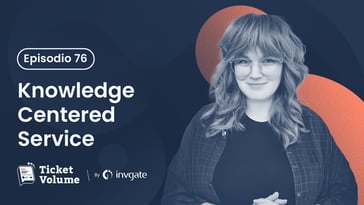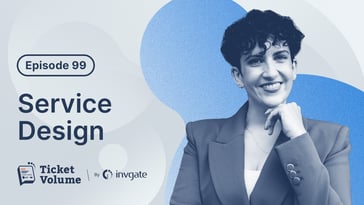In a nutshell, Enterprise Service Management (ESM) consists of extending the IT Service Management (ITSM) framework into other areas of the organization. But despite sounding like such a simple task, you might find it challenging in practice. If you're implementing an ESM framework in your organization, then this is just what you need!
On the 36th episode of Ticket Volume, our IT podcast, Darren Rose shared ten Enterprise Service Management implementation tips to follow when designing your ESM strategy. And believe us, he knows what he's talking about. He's a Service Management consultant with more than 15 years of experience introducing ESM practices across other departments in the construction industry.
As you know, you can keep reading to find a quick written recap of the episode, but we seriously recommend that you listen to the whole thing! And remember that you can register for our monthly live recordings and ask your questions live!

How to transition from ITSM to ESM
According to Rose, the transition from ITSM to ESM doesn't quite make sense. From his point of view, it's more about a change in culture rather than an introduction of new tools – "the new shiny thing," anybody?
His concern lies in the fact that what is now self-labeled as "ESM tools" doesn't solve the transition by itself. On the contrary, it's really about having the right people in the right roles with proper funding and structure to deliver good Service Management practices.
Consulted by Matt Beran – the podcast host and InvGate Product Specialist – on the common boundaries to companies starting their ESM journey, the guest mentioned:
|
|
Darren Rose |
10 Enterprise Service Management implementation tips
So, to overcome this and other roadblocks along the way, Rose shared some advice that can make implementing ESM in an organization much smoother – and eventually succeed at it!
1. Break down language barriers
People often resist new tools or ideas because they believe their way of doing things is unique. However, you can understand what everyone means when you break down language barriers and have extended conversations with them.
Furthermore, Rose pointed out that different departments might use different languages for the same thing, so it's essential to use their language and work out what that is.
2. Maintain silos while joining them
Though it might sound a bit confusing, the guest made an excellent point about tackling a common issue right from the beginning. Implementing ESM is not about tearing down silos entirely. Maintaining some aspects of them as necessary since removing everything can be difficult.
|
|
Darren Rose |
This way, you'll respect the knowledge and skill in all those silos while making it more of a collective effort. In addition, for Rose, it's easier to join up silos if they're engaged with two different teams since you get the same offering at the end.
3. Identify ideal candidates for the transition
Another implementation tip for ESM is to spot the right areas to start the journey. The guest recommended cross-functional processes as ideal candidates for Service Management platforms.
The most obvious teams are HR and Finances since they already have a link to IT.
4. Put together an implementation plan
A sequenced and orchestrated work in the background is also crucial to achieving the outcomes end-users are after. Implementing an ESM strategy improves employee experience since they don't wonder who they need to contact anymore.
With ESM, end-users just submit a request, and the service desk does the rest – if the ITSM tool is correctly configured, of course!
5. Think beyond processes
The same as with silos, another ESM good practice is to think beyond processes and specific silos. Instead, try to encourage workers to share knowledge (but in a way that doesn't make them fear it will make their job irrelevant).
Using value chains, for instance, can help visualize value in terms of how sharing knowledge can impact revenue.
6. Adapt to new ways of working
Over the last few years, in particular, we've witnessed a profound digital transformation – propelled mainly by the Covid pandemic – that affected how we worked. ESM can become an excellent way to adapt and support new working methods by joining employees and understanding their needs.
After all, one of Service Management's core principles is to empower organizations to adapt quickly in changing situations.
7. Be Agile
But to adapt to the new working methods, it's also essential to be Agile. According to Rose, agility enables managing workloads differently and provides organizations with defined processes, people, and experience that allows them to adapt and scale.
FREE Enterprise Service Management CourseElevate customer satisfaction and optimize organizational performance. |
8. Automate
Another critical aspect of ITSM that shouldn't be overlooked in the transition to Enterprise Service Management is automation. It's another central principle of the framework (and one of its reasons to be), allowing organizations to streamline repetitive tasks while providing employees with autonomy. And that's definitely something you should enable for other areas beyond IT!
9. Focus on experience
But Enterprise Service Management goes beyond automation and established processes all the way through the experience. Experience Management is the engine behind all; it's what makes you choose and act, and improving it is doing Service Management right.
Rose recommended breaking down experience into two types: user and employee – or the people receiving and providing the service – to properly addressed each.
|
|
Darren Rose |
10. Motivate your employees
For Rose, autonomy, mastery, and purpose are the intrinsic motivators workers have, and they can all be achieved with ESM since:
- Employees have the autonomy to make the right decisions and do the right things.
- They mastered their job because they didn't have to do repetitive work anymore.
- They have a sense of purpose given by the notion of service.
In conclusion
This is just a short recap of Ticket Volume's episode with Darren Rose, but there's much more on the recording. So, make sure to catch up on the full chat with Matt Beran to learn more about Enterprise Service Management implementation!
You can find the full episode on Apple Podcasts, Spotify, YouTube, or your favorite podcast platform. And remember to subscribe if you want to be a part of the monthly live recordings!
















